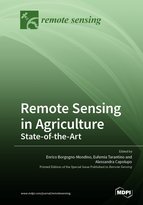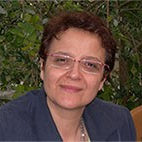Remote Sensing in Agriculture: State-of-the-Art
A special issue of Remote Sensing (ISSN 2072-4292). This special issue belongs to the section "Remote Sensing in Agriculture and Vegetation".
Deadline for manuscript submissions: closed (31 December 2020) | Viewed by 64917
Special Issue Editors
Interests: remote sensing; spatial analysis and landscape planning; GIS; digital photogrammetry; precision farming; lidar
Special Issues, Collections and Topics in MDPI journals
Interests: geomatics; optical remote sensing; pixel-based and geographic object-based image analysis (GEOBIA); UAV applications; digital photogrammetry and spatial analysis; methodologies for multi-temporal analysis (change detection) and classification of optical satellite sensor data aimed at environmental, agricultural and cultural heritage monitoring and documentation
Special Issues, Collections and Topics in MDPI journals
Interests: remote sensing, digital photogrammetry and spatial analysis for heavy metals detection
Special Issues, Collections and Topics in MDPI journals
Special Issue Information
Dear Colleagues,
The Special Issue Remote Sensing in Agriculture: State-of-the-Art is intended to assemble high-level contributions giving an exhaustive overlook of the ongoing remote sensing technology transfer into the agricultural (crops and forests) sector. Contributions from authors should not report simple case studies but more properly highlight opportunities, limitations, and criticalities still persisting in this context.
The following themes are warmly encouraged:
- Design and implementation of institutional services for agriculture (controls and management) based on satellite/aerial/UAV data with special concerns about image time series and monitoring instances;
- Technical criticalities/limitations/potentialities and possible solutions of new low-cost sensors with special concerns about UAV (unmanned aerial vehicle) and UGV (unmanned ground vehicle)-based systems;
- Remote sensing data processing for agronomic information retrieval (both qualitative and quantitative). Works presenting procedures to validate prescription maps and criteria definition to derive reliable intensity rates of agronomic interventions from RS data are encouraged;
- Crop water requirement estimation from RS data;
- Crop yield estimation from RS data;
- Phytopathological alerts for crops, based on RS data;
- Economical evaluations concerning costs of RS, actual, and forecasted income improvements in the agriculture sector, potential market;
- Relationship between ground and RS data with special concerns about future scenarios were BIG DATA from distributed ground sources (networks of distributed sensors, smartphone-based ground observations, etc.), will enter the RS workflow;
- Standardization of processes and outputs
All other issues related to the adoption of RS in the agriculture sector will be evaluated, as well.
Prof. Dr. Enrico Borgogno-Mondino
Prof. Dr. Eufemia Tarantino
Dr. Alessandra Capolupo
Guest Editors
Manuscript Submission Information
Manuscripts should be submitted online at www.mdpi.com by registering and logging in to this website. Once you are registered, click here to go to the submission form. Manuscripts can be submitted until the deadline. All submissions that pass pre-check are peer-reviewed. Accepted papers will be published continuously in the journal (as soon as accepted) and will be listed together on the special issue website. Research articles, review articles as well as short communications are invited. For planned papers, a title and short abstract (about 100 words) can be sent to the Editorial Office for announcement on this website.
Submitted manuscripts should not have been published previously, nor be under consideration for publication elsewhere (except conference proceedings papers). All manuscripts are thoroughly refereed through a single-blind peer-review process. A guide for authors and other relevant information for submission of manuscripts is available on the Instructions for Authors page. Remote Sensing is an international peer-reviewed open access semimonthly journal published by MDPI.
Please visit the Instructions for Authors page before submitting a manuscript. The Article Processing Charge (APC) for publication in this open access journal is 2700 CHF (Swiss Francs). Submitted papers should be well formatted and use good English. Authors may use MDPI's English editing service prior to publication or during author revisions.
Keywords
- Free satellite Data
- RPAS/UAV
- Copernicus
- Prescription maps
- Crop Management
- Crop Monitoring
- Crop Water Requirements
- Services in Agriculture
- Crop Productivity
- Data Process Standardization








